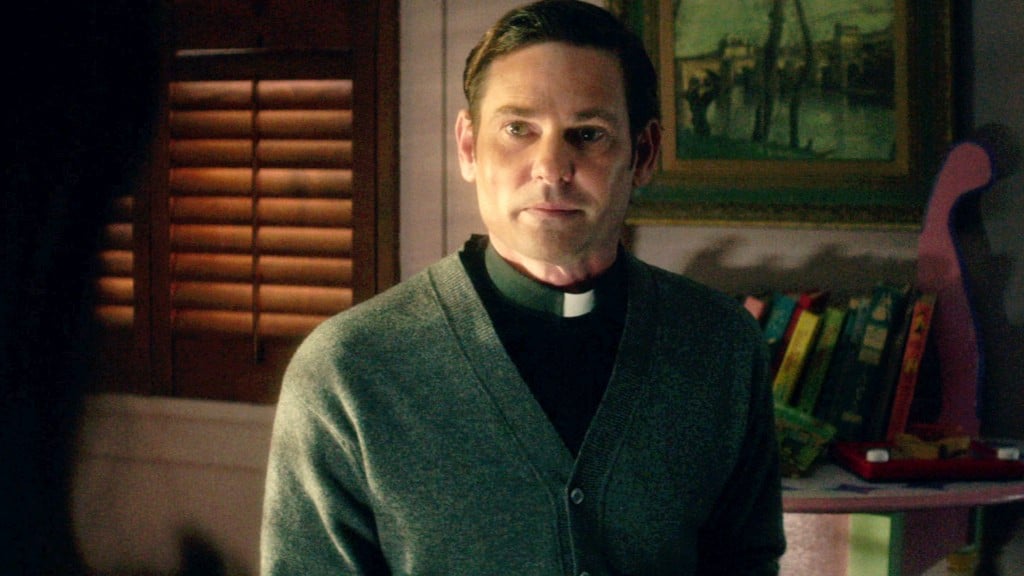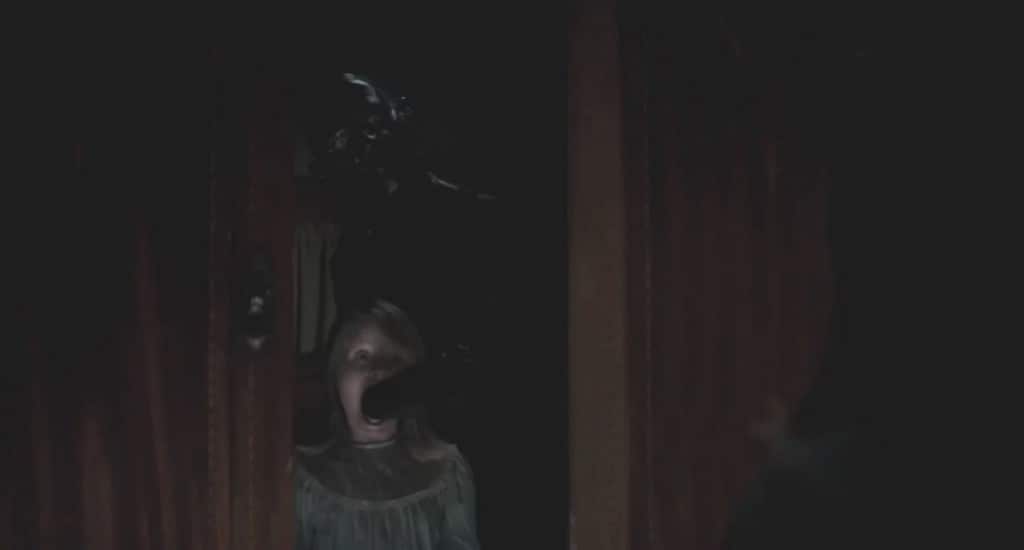
Ouija: Origin of Evil (2016)
Commentator: Mike Flanagan (director, co-writer, editor)
1. Starting with the old-school Universal logo at the film’s opening, Flanagan was excited to “recreate” the experience he had as a kid getting into the horror genre. This includes the title card and the cigarette burns marking the reel changes. “It was really important for us to try from the very beginning to make this as an immersive, kind of nostalgic experience as we could.” Universal liked the approach and offered the logo.
2. The opening seance scene is the reason he wanted to make the movie. He liked the idea of a family trying to help ease people’s concerns about loved ones but doing so with fraudulent means.
3. The young woman with the blond hair is played by Kate Siegel, who recently collaborated with Flanagan on the terrific little thriller Hush.
4. They shot the entire movie on antique lenses, and while they shot the film anamorphic they cropped the sides to make it fit the 16:9 aspect ratio. “You’ll notice a lot of the artifacts in anamorphic filmmaking in the way it handles light. It was a very fun way to work.”
5. He wrote this script with Annalise Basso in mind for the teenage lead, Lina, having worked with her on Oculus.
6. They rigged Alice’s (Elizabeth Reaser) seance table to do the various things the character needed it to do including building the candles with tubing that allowed someone to blow them out from within. They learned the hard way that when you let a candle burn for a short while before blowing it out this way “it sprays boiling wax out in all directions.”
7. The exterior and interior of the family’s house are actually two different houses, and both were used in the first Ouija. Curiously, the interior was also used in Lights Out. That film wrapped two days before this production moved in.
8. They chose zooms over (camera) dolly moves whenever possible “just because it was a technique that was really, really popular in the ’60s and ’70s and kind of went out of vogue.”
9. Flanagan recognizes a stigma towards PG-13 horror films and doesn’t find it a fair assessment. He’s correct in pointing out that typically “the only real difference is the level of gore and violence” and that “13 year olds deserve movies with complex characterizations and sophisticated aesthetics just as much as anyone else,” but the difference he’s missing is that the PG-13 horror films we all hate are typically the studio cash-grabs looking for big opening weekend numbers from highschoolers. The rating itself isn’t the problem.
10. He’s no fan of jump scares in general or as a mandate that horror films feature one every few minutes. “I think they disrupt the tension that you try to build.” The Ouija board scene with the teens at the party is a nod to the first film and that idea of jump scares and “the one false jump scare of the movie. Nothing drives me crazier than the cat jumping into frame or someone tapping someone on the shoulder, and that being kind of turned into a jump scare.”
11. The last day of production was reserved for shooting all of the close-ups of the Ouija board using hand doubles spelling out everything that happened on the board in every scene of the film.
12. The Ouija game box is an exact match to the packaging from the ‘60s.
13. The driving scene was made period authentic in part by not having Alice or her two kids worry about seat belts. Flanagan loves seeing Doris (Lulu Wilson) pop up into the front seat while the car is moving, but he acknowledges that as a father of a six year old he would lose his mind if his own kid did that.
14. He loves the sound design of including the grandfather clock sounds at various parts of the film despite there being no grandfather clock in the house.
15. He describes the scene where Lina’s sheet is pulled from the bed as a “low-tech scare” and acknowledges that the expected instinct is to score it for added effect. I’m of the opinion that sound cues lessen scares more often than enhance, so I love his decision here and at a few other terrifying moments in the film to avoid them.
16. The demon in Lina’s doorway after the above sequence was added in post. Flanagan’s only caveat was that he again insisted there be no audio sting announcing his presence.
17. The film originally featured a scene with Father Tom’s (Henry Thomas) dead wife in the third act, but he removed it for being a bit confusing and for slowing down the momentum. It’s available as a deleted scene on the Blu-ray/DVD.

18. The family drives past Murdoch’s house from Lethal Weapon around the 26:36 mark. The driving scenes were shot on the WB lot.
19. Flanagan and co-writer Jeff Howard made a point of making the characters worth caring about even with the supernatural elements removed. To that end their first pass of the script “actively avoided the genre elements until the midpoint because we wanted to spend time with the family.” This is a terrific approach, and more filmmakers would benefit from following suit.
20. The 90 degree tilt shot – seen here at the 33:25 mark – is something of “an in-joke” between Flanagan and cinematographer Michael Fimognari, and they’ve made room for it in each of their films starting with Oculus. “Now it’s kind of a dare to see if we can find a way to get it in that makes sense for the story.”
21. He credits Universal, Blumhouse, and Platinum Dunes with allowing him to take the time with his first act – a full forty minutes basically – getting to know the characters before “pressing the gas” on the horror.
22. Doug Jones plays the demon in the mirror who bends Doris backwards and shoves his fist down her throat. Flanagan first met Jones when the performer joined him briefly on the director’s debut, Absentia.

23. They wanted to ensure this film stands on its own despite technically being a prequel to Ouija. Fans will still find connections, but they wanted viewers to enjoy this one on its own.
24. He thinks the best kiss ever captured on film is the one between James Stewart and Grace Kelly in Rear Window, so he recreated it here with Lina and Mikey (Parker Mack). They digitally added a Rear Window poster onto the wall in post after getting permission from Universal.
25. Little Lulu Wilson chose the strangulation monologue (from the 51:00 mark) for her audition, but unlike other young actresses who played it blatantly creepy she went the casual and pleasant route. The scene in the film is her first take, and while he intended on cutting between her and Mikey he instead stayed on Wilson’s face.
26. Yes, the shot at 57:56 is “absolutely” a nod to The Exorcist’s poster.
27. He says it’s a genre staple to have a scene where the characters talk and someone explains the nature of the haunting, but rather than speed it up they instead “leaned into it” banking on performances, editing, and cinematography. He braids the Doris and Mikey basement scene into Father Tom’s “campfire tale” to increase tension and momentum.
28. The Oculus mirror makes a cameo at the 1:07:07 mark.
29. He thinks cinema’s best jump scare is the underwater face startling Hooper in Jaws, and he tried to homage it with the skull in the wall.
30. Flanagan had to remind himself that characters splitting up in a horror film is “the stupidest idea in the world.”
31. They looped dozens of voice performers and created a mix to use as Doris’ possessed voice.
32. He was surprised they got away with hitting a nine year old with a chair, “but I guess since one of the only things we knew had to happen by the end of the film was that we had to murder a nine year old on camera I guess the chair was not too bad.”
33. They re-shot the bit at the end where Lina stabs her mother. It originally ended with Lina still possessed, but they wanted to give the pair a chance to say goodbye to each other.
34. The film originally ended with the shot of Lin Shaye as the adult Lina, but they chose to move that to the post-credits and instead focus on giving viewers a look Lina’s time in the asylum and one last scare.
35. His first reaction to being offered a sequel to Ouija was one of “intense skepticism.” (As a horror fan, and a Flanagan fan, I had the same reaction, but I won’t be making that mistake again.) The producers told him they wanted to create something unique that stood apart from the original while still keeping the Ouija game front and center.
36. He fell in love with film scores as a teenager working as a theater usher and cleaning the aisles and seats as the end credits rolled.
37. Some viewers, upon seeing Shaye appear at the end and having not seen the first Ouija, apparently thought this was somehow connected to the Insidious films.
38. Movies mentioned as influences and/or references include Ouija, Lights Out, The Exorcist, The Changeling, Poltergeist, Watcher in the Woods, and Jaws.
Best in Context-Free Commentary
“It’s always so refreshing to me, silence in a horror movie.”
“Father cock-block, good to see you.”
“Everything about this I love, except it looks like Kool-Aid in their glasses. You can’t win them all.”
“I don’t want to take a selfie without Michael Fimognari at this point in my life.”
“Yeah, that was a cheap one. I admit it.”
“Lulu insisted on doing her own stunts.”
Ouija: Origin of Evil (Blu-ray + DVD + Digital HD)
Final Thoughts
This is one of 2016’s best horror films, and I wish I had seen it before compiling my list. Flanagan in some ways feels like a director in line with James Wan’s style of creative visuals and sound design. Wan obviously uses more audio jump scares, but he also respects the power of silence which is something Flanagan takes full advantage of here. Both filmmakers go above and beyond the typical genre efforts we see coming out of Hollywood, and Flanagan does a beautiful job crafting atmosphere with scares, smarts, and characters we care about. That alone elevates it above the fray in terrifically entertaining ways.
Read more Commentary Commentary from the archives.
Related Topics: Commentary Commentary, Filmmaking, Home Video
